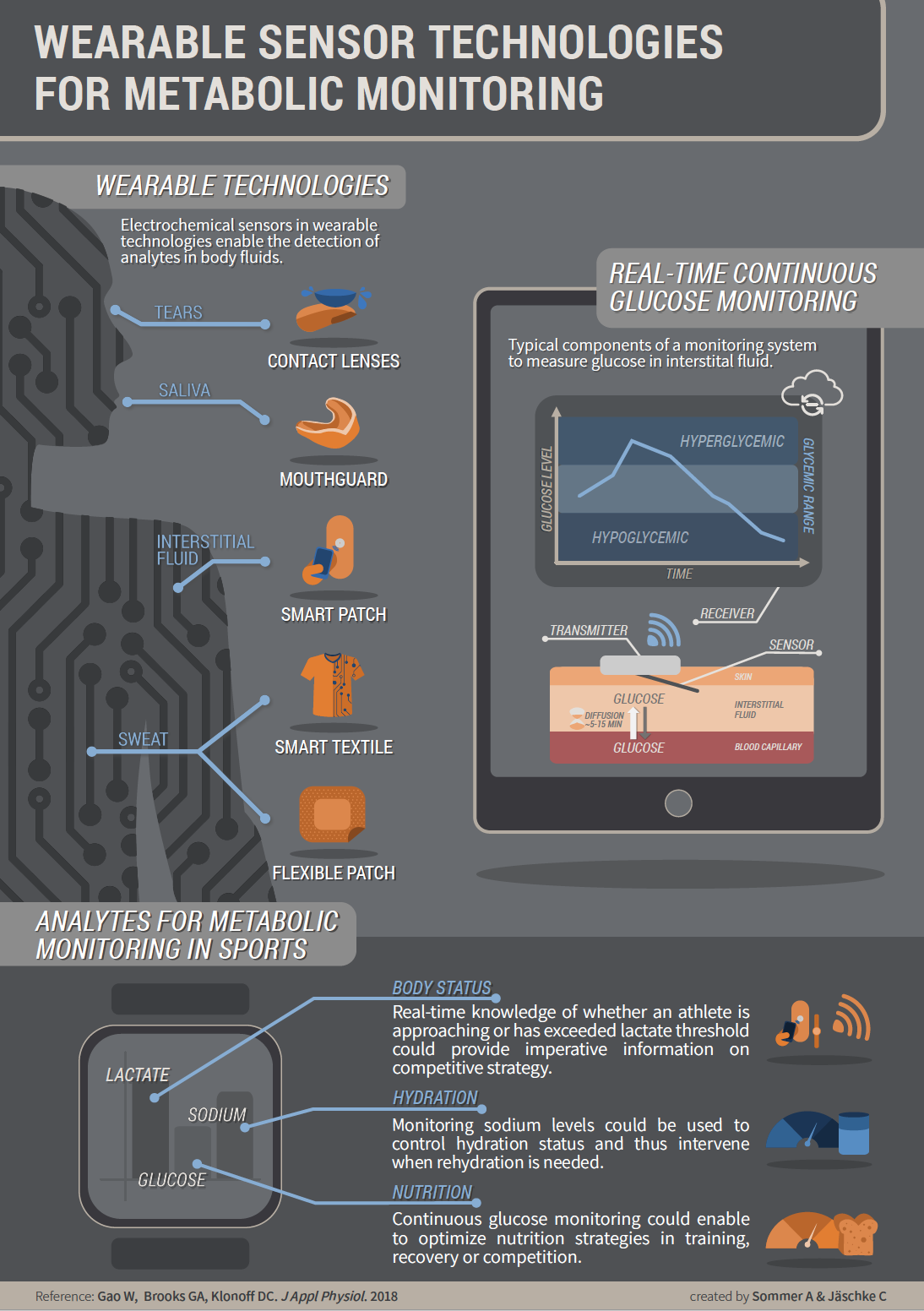Wearable sensor technologies for metabolic monitoring in sport – What do they measure? And what are the benefits for sport performance?
Wearable sensor technologies offer the possibility to measure a wide range of analytes in various body-fluids. Monitoring metabolic processes through analytes (e.g., lactate, glucose, etc.) could provide critical information about the condition of athletes for timely intervention. The aim of this blog entry is to summarize the key messages of the review article of Gao, Brooks and Klonoff [1] for metabolic monitoring in sport.

Monitoring glucose levels – typical sensor components, measurement accuracy, and benefits of practical application
Current wearable technologies (lenses, mouthguard, patches, or smart textiles) are easy to applicate, and could enable to monitor physiological processes in sports. Continuous glucose monitoring (CGM) through interstitial fluid (ISF) is already approved in wearable technology [1]. A ISF based CGM-system typically consists of a wearable sensor (inserted with a needle through the skin), a transmitter to send glucose data, and a receiver to monitor and save data [2]. CGM-systems have a mean absolute relative difference (MARD) of around 10%, which is a threshold to be considered by the FDA as safe for nonadjunctive use [1]. Accordingly, no additional fingerstick blood glucose test is needed before intervention, and blood waste of fingerstick through capillary blood glucose testing could be prevented. Besides the benefits of CGM for patients with diabetes, physiological research might also profit from knowledge about the time spend in a certain glycemic range [1]. However, monitoring glucose levels through ISF has some limitations. Changes in ISF glucose levels lag behind the corresponding blood glucose levels by approximately 5-15 minutes, which has to be considered in data interpretation [2].
Real-time monitoring of physiological processes in sport – possible application fields in near future
Body fluids, like tears, sweat, saliva, or ISF, display a range of analytes associated with different physiological processes, such as lactate, glucose, hydrogen ions, uric acid, sodium, or potassium. Real-time information about ongoing metabolic processes could be used to strategically intervene in training or sport competition. For example, athletes are sometimes exposed to conditions that can lead to dehydration. At the Tokyo Olympic Games in summer 2021 athletes faced heat and humidity. In such extreme environmental conditions, wearable technology could have been used to prevent dehydration by providing information about sodium status to maintain optimal hydration status [3]. Further, metabolic monitoring could enable to strategic intervene during competition, training, or recovery. For instance, knowledge of whether an athlete has approached or exceeded lactate threshold provides invaluable information for tactical adjustment in sports competition [4]. Moreover, monitoring glucose levels of an athlete offers great potential to manage carbohydrate intake in recovery, or before and in competition [5].
Conclusion
The application of wearable technologies for metabolic monitoring in sports could provide key information for athletes, trainers, coaches, and dietitians to strategically manage rehydration and nutrition, and to adopt tactical approach in competition. Given the current state of technological development in the presented wearable sensor technology, the measurement of ISF offers the greatest potential for real-time metabolic monitoring in sports.
About the authors:
Aldo Sommer (Twitter: @Aldoswelt) is a sport scientist interested in exercise physiology and cognitive psychology. He works as a research assistant at the German Sport University Cologne and at the University of Hagen. In his research, he investigates the relationship between performance and fatigue depending on the individual physiological profile of an athlete, and the interplay between the autonomic nervous system and cognitive function.
Carolin Jäschke is a sport scientist and communication design student. Her research interest is the knowledge transfer from science to practice. Here, she explores the question of how performance diagnostic reporting can be presented in a visually understandable way for coaches and athletes.
Competing interests
No competing interests declared. Further, there were no specific grant for this research from any funding agency in the public, commercial or not-for-profit sectors.
References
- Gao W, Brooks GA, Klonoff DC. Wearable physiological systems and technologies for metabolic monitoring. J Appl Physiol 2018;124(3):548–56. https://doi.org/10.1152/japplphysiol.00407.2017
- Freckmann G. Basics and use of continuous glucose monitoring (CGM) in diabetes therapy. J Lab Med 2020;44(2):71–79.
- Villiger M, Stoop R, Vetsch T, et al. Evaluation and review of body fluids saliva, sweat and tear compared to biochemical hydration assessment markers within blood and urine. Eur J Clin Nutr 2018;72(1):69–76.
- Saunders PU, Cox AJ, Hopkins WG, & Pyne DB. Physiological Measures Tracking Seasonal Changes in Peak Running Speed. J Sport Physiol Perform 2010;5(2):230-238.
- Burke L, Hawley J, Wong S, et al. Carbohydrates for training and competition. J Sports Sci 2011;29:17–27.